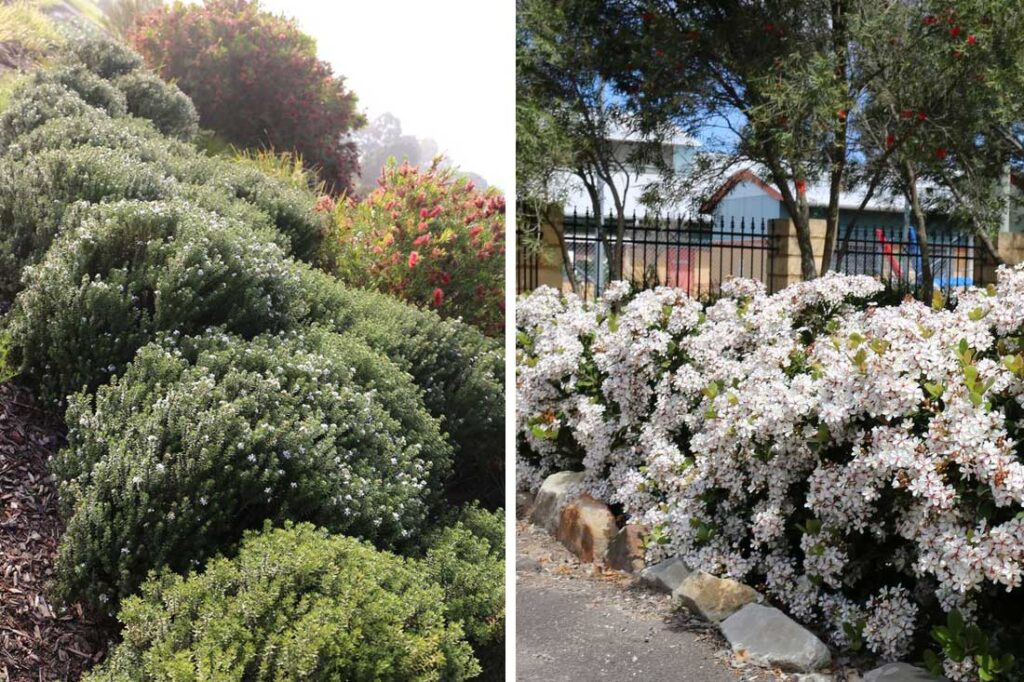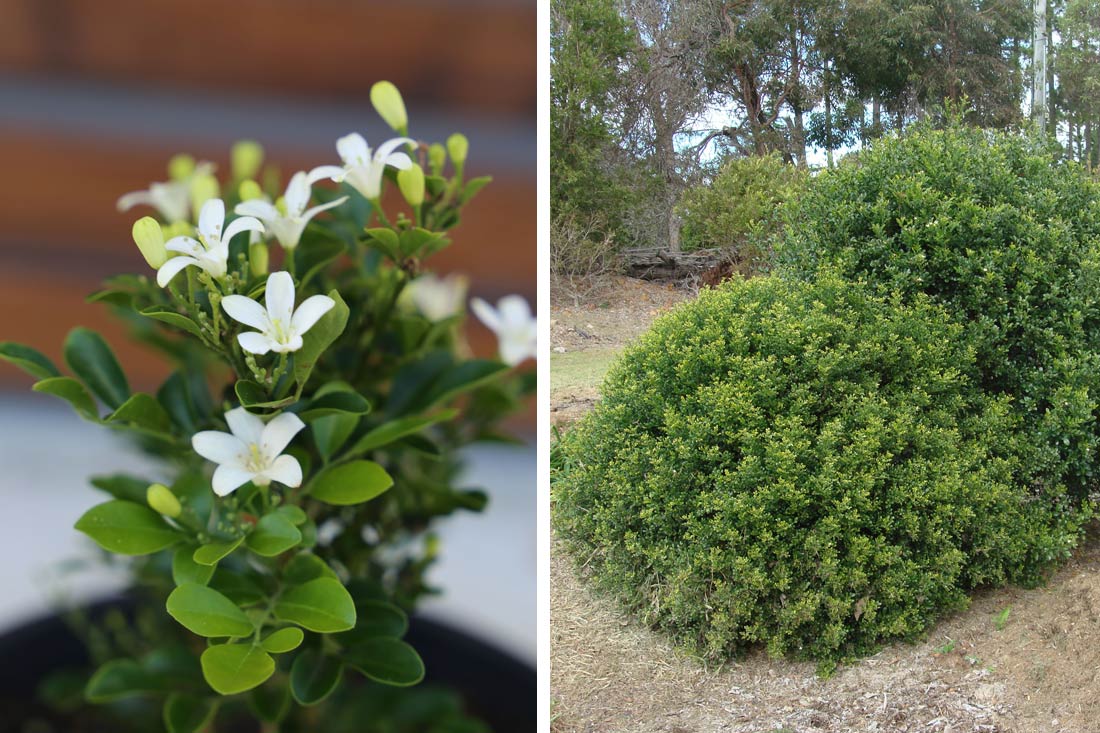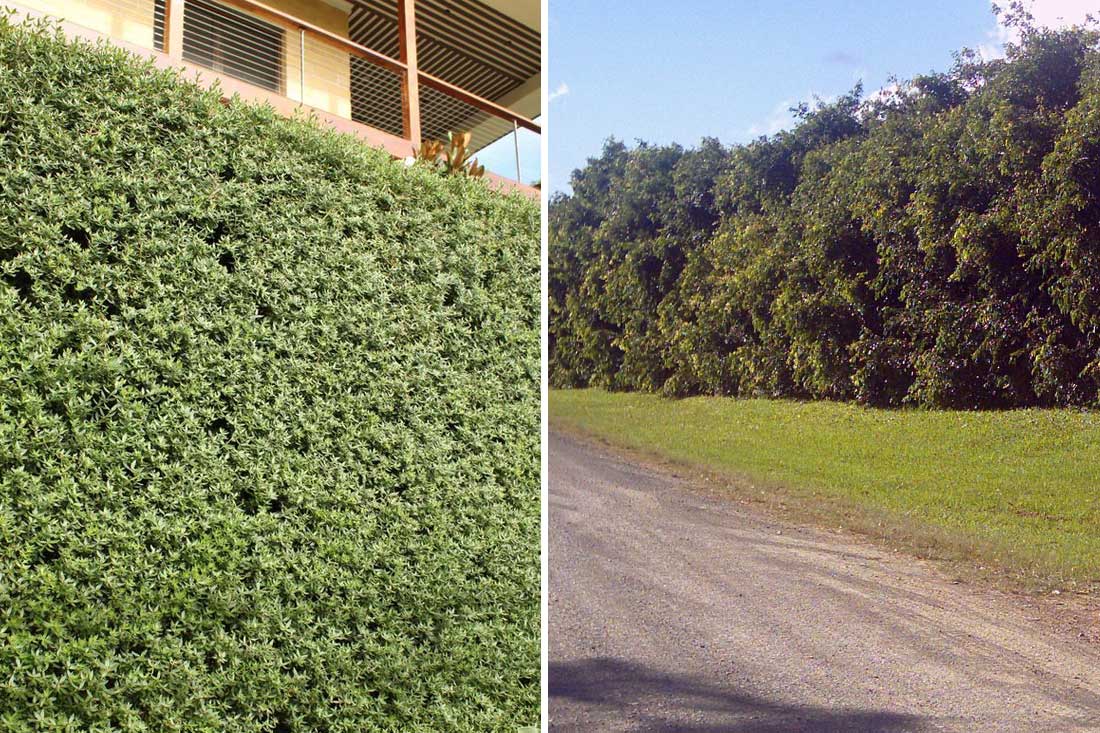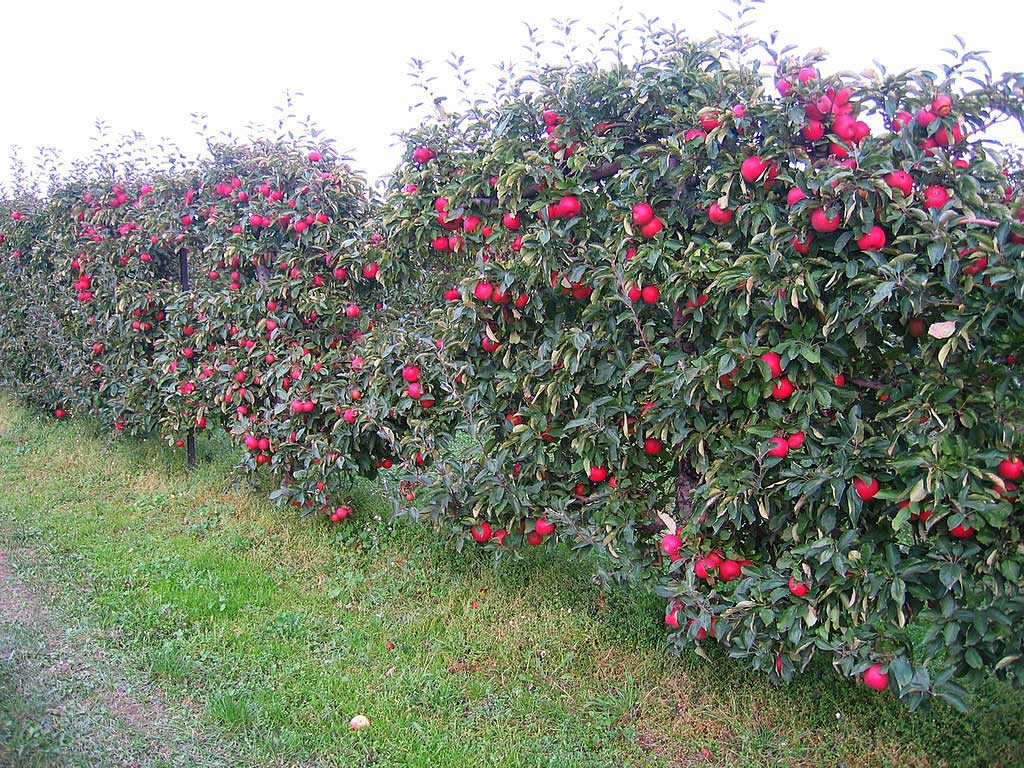South-facing slopes can present numerous challenges due to their aspect in relation to the equator and the sun in Australia, as well as a narrow soil profile (often laden with rocks) that drains too quickly for most plants.
Beyond these already demanding conditions, wind, gravity, and rainfall are constantly attempting to erode the sparse topsoil. This article will explain the challenges related to growing hedges and shrubs on south-facing slopes in Australian landscapes and provide a selection of hedges and screens that can thrive in these harsh conditions.
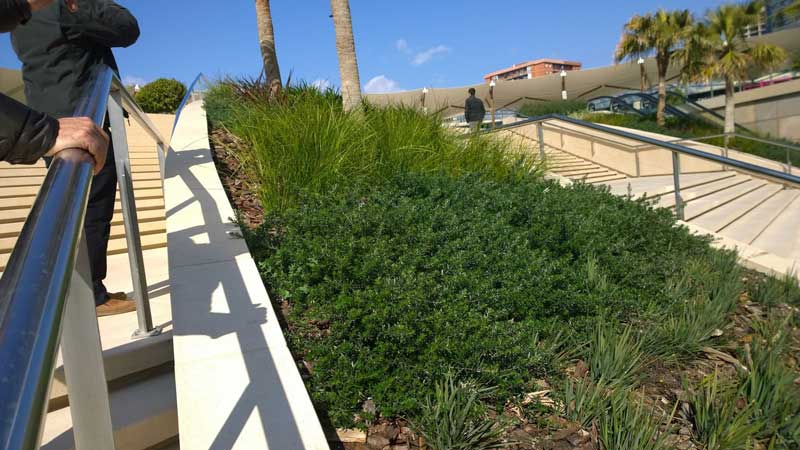
Steep slopes can be a tricky growing environment for hedges and screens. This low-growing hedge is very happy in this position because the ground is covered and it’s a particularly tough plant. Mundi™ Westringia fruticosa‘WES05’ PBR.
Conditions of a South-Facing Slope in a Garden
South-Facing Aspect
In Australia, a south-facing slope in a garden typically receives less sunlight throughout the day due to its orientation away from the equator compared with a north-facing slope. This results in less sunlight overall compared with a north-facing slope, creating a cooler microclimate that can be easier for plants to adapt to.
Environmental Conditions of a Slope
The environmental conditions of a slope, irrespective of its aspect, come with inherent challenges and opportunities for gardening:
Drainage
Slopes inherently provide better drainage compared to flat or depressed areas. Water tends to run off more quickly, which can prevent waterlogging but may also require more frequent watering or irrigation during dry spells.
Soil Erosion
The gradient of a slope can accelerate soil erosion, especially when the soil is exposed during heavy rains and strong winds. Mulch can be effective on gradual slopes, but ground-covering plants are more effective on steep slopes. Planting ground covers or using terracing methods can help stabilise the soil and mitigate erosion.
Micro Climates
Slopes can create microclimates owing to variations in sunlight exposure, wind patterns, and moisture levels. The upper part of the slope may be drier and more wind-exposed, while the lower part may retain more moisture.
Plant Selection
Plants suitable for a sloped garden must be chosen carefully. Drought-tolerant species are ideal for the upper sections of the slope, while moisture-loving plants might flourish at the lower sections where water tends to collect. Assuming they aren’t in shade, plants should be tolerant to full sun to part shade on a south-facing slope.
Consequences of Erosion on a Slope
Loss of Topsoil and Nutrients
Erosion on a slope can result in significant loss of topsoil, the most fertile layer containing essential nutrients and organic matter necessary for plant growth. When topsoil is eroded, the underlying layers are usually less fertile and less capable of supporting healthy vegetation. This nutrient depletion can stunt plant growth and diminish the overall productivity of the garden.
Exposing Roots
Erosion can expose the roots of plants on the slope if left untreated. Exposed roots are exposed to the elements, when they prefer to be submerged and undisturbed within the soil. This can lead to weak plants that are more susceptible to disease which quickly leads to plant death and further soil destabilisation.
Preventative Measures
Terraces
Levelling out terraces can be expensive, but it does improve conditions for plants drastically by providing a level space for water to infiltrate into the soil rather than washing down the slope. However, it’s not necessary to outlay this expense if you can control erosion and specify resilient plants.
Mulch
Mulch helps retain moisture in the soil, reduces runoff, and adds organic matter to the soil as it decomposes. It’s a great option for covering soil on a gradual slope, however, mulch may slide down steeper slopes due to gravity.
Ground Cover Plants
Planting ground cover plants is a highly effective strategy to prevent soil erosion, especially where mulch isn’t suitable. These plants shield the soil from direct exposure to sunlight, wind, and rain, key contributors to erosion. Their roots physically bind the soil, creating a network that stabilises the surface layer. Examples of effective ground covers include:
- Strappy-leaf plants: These plants have long, narrow leaves that can slow water flow and trap soil particles.
- Grasses: Grasses are particularly effective at controlling erosion due to their fibrous root systems that knit the soil together.
- Trailing plants: These are ground covers with trailing stems that protect the soil’s surface and crowd out weeds if their growth is dense enough. It’s generally the case that strappy plants have better root systems for erosion control than trailing plants, but that’s not a hard-and-fast rule.
Best Hedges and Screens for South-Facing Slopes
These plants are suited to conditions of reduced sunlight, typical of south-facing slopes in Australia.
They may or may not be resilient to erosion and exposed roots if you fail to control it with quality ground-covering plants, so make sure you take steps to control erosion.
Some plants are suitable for both drought and wet feet, as well as full sun and part shade, making them appropriate for both elevated and lower areas of a slope experiencing periodic drought and flooding. Check the description on each plant.
Some plants are tall hedges suitable for screening, while others are better suited for low hedges, border definition, and roadside slopes with unobstructed lines of sight.
Browse our ground-covering native plants here: Ozbreed Native Shrubs & Groundcovers.
Cosmic Pink™ Rhaphiolepis indica ‘RAPH02’ PBR
Cosmic Pink™ Rhaphiolepis is a super tough, compact evergreen shrub with a mounding habit. It features large, showy pink flowers that bloom through spring and summer. This cultivar is exceptionally hardy, tolerating extreme weather conditions (such as flooding, drought, and frost) and rarely producing seeds.
Size:
- Height: 50 – 80 cm
- Width: 50 – 80 cm
Preferences:
- Position: Full sun to moderate shade
- Soil Type: Suitable for sandy to well-drained clay soils. Tolerates frost, drought, and coastal conditions.
Care:
- Water as required for 8-13 weeks until established.
- Plant in a well-mulched garden with chunky mulch recommended.
- Use slow-release fertiliser in spring if necessary.
- Prune 1-2 times a year after flowering to maintain shape, depending on desired tidiness.
Climate (Where it works):
- Queensland (QLD)
- New South Wales (NSW)
- Australian Capital Territory (ACT)
- Victoria (VIC)
- Tasmania (TAS)
- Northern Territory (NT)
- South Australia (SA)
- Western Australia (WA)
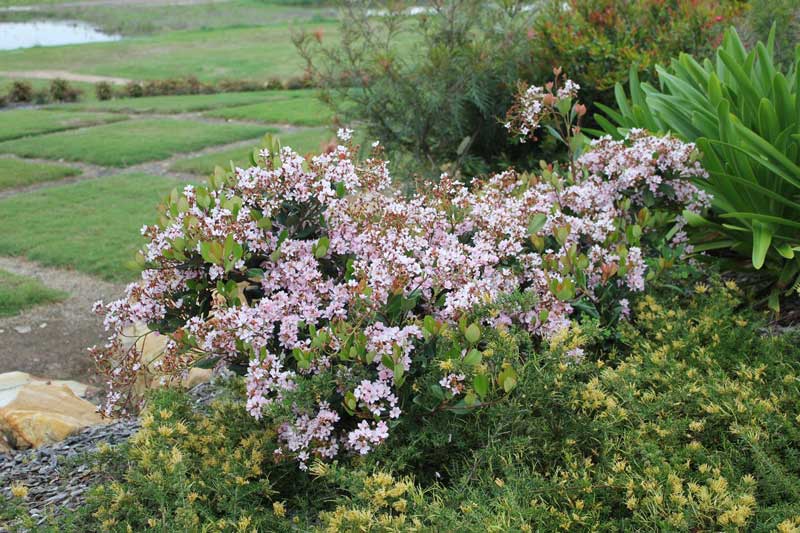
https://www.ozbreed.com.au/plant-ranges/hardy-exotic-range/cosmic-pink-rhaphiolepis/
Cosmic White™ Rhaphiolepis indica ‘RAPH01’ PBR
Cosmic White™ Rhaphiolepis is a robust evergreen shrub that flowers profusely in the spring, with additional spot flowering occurring throughout the year. The flowers are larger than those of the common form, and the plant boasts very clean foliage along with excellent disease resistance. It’s disease resistant and tolerant of both flooding and drought.
Size:
- Height: 1.5 – 2 metres
- Width: 1.5 metres
Preferences:
- Position: Full sun to moderate shade
- Soil Type: Tolerates sandy to clayey soils
Care:
- Water as required for 8-13 weeks until established.
- Plant in a well-mulched garden, with chunky mulch recommended.
- Use slow-release fertiliser in spring if necessary.
- Prune to shape every two years after flowering, if required.
Climate (Where it works):
- Queensland (QLD)
- New South Wales (NSW)
- Australian Capital Territory (ACT)
- Victoria (VIC)
- Tasmania (TAS)
- Northern Territory (NT)
- South Australia (SA)
- Western Australia (WA)
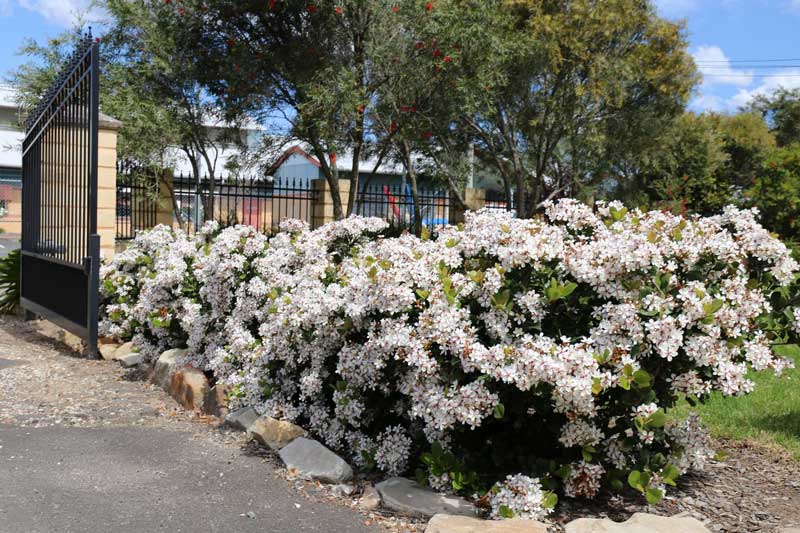
https://www.ozbreed.com.au/plant-ranges/hardy-exotic-range/cosmic-white-rhaphiolepis/
Better John™ Callistemon viminalis ‘LJ1’ PBR
Better John™ Callistemon is a new cultivar bred from Little John, featuring blue-green mature foliage with silver tones on new growth due to its soft, hairy texture. It produces small red flowers that bloom from mid to late spring. It’s tolerant of flooding and drought, and also resistant against myrtle rust and phytophthora.
Size:
- Height: 60 cm – 1.2 metres
- Width: 60 – 90 cm
Preferences:
- Position: Full sun to part shade
- Soil Type: Suits sandy to clayey soils. Tolerant of flooding, drought and cold conditions.
Care:
- Water as required for 8-13 weeks until established.
- Plant in a well-mulched garden, with chunky mulch recommended.
- If necessary, use slow-release fertiliser in spring.
- Prune every 3-4 years for a natural shape or every 2 years for a tidy hedge if required.
Climate (Where it works):
- Queensland (QLD)
- New South Wales (NSW)
- Australian Capital Territory (ACT)
- Victoria (VIC)
- Tasmania (TAS)
- South Australia (SA)
- Western Australia (WA)
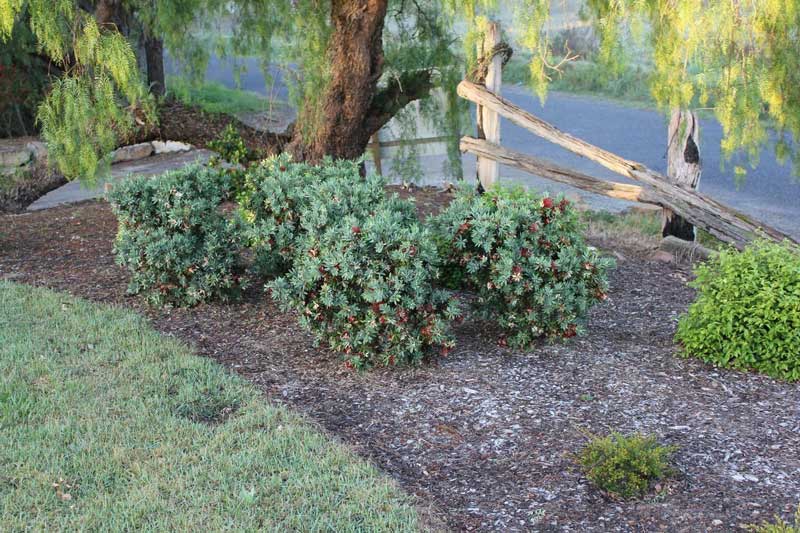
Macarthur™ Callistemon viminalis ‘LC01’ PBR
Macarthur™ Callistemon is a compact, well-flowering cultivar that combines traits from the popular Little John and Captain Cook varieties. It boasts fresh green foliage with very bushy and tidy growth, making it an attractive choice for sloped gardens. The plant responds very well to pruning after flowering. It’s tolerant of flooding and drought, as well as being resistant against phytopthora and and myrtle rust.
Size:
- Height: 1.8 metres
- Width: 1.5 metres
Preferences:
- Position: Full sun to part shade
- Soil Type: Tolerates most soil conditions, including those exposed to frost and drought.
Care:
- Water as required for 8-13 weeks until established.
- Plant in a well-mulched garden, with chunky mulch recommended.
- If necessary, use slow-release fertiliser in spring.
- Prune to shape 1-3 times per year after flowering to maintain a hedge; more frequent pruning will result in a tidier appearance.
Climate (Where it works):
- Queensland (QLD)
- New South Wales (NSW)
- Australian Capital Territory (ACT)
- Victoria (VIC)
- Tasmania (TAS)
- South Australia (SA)
- Western Australia (WA)
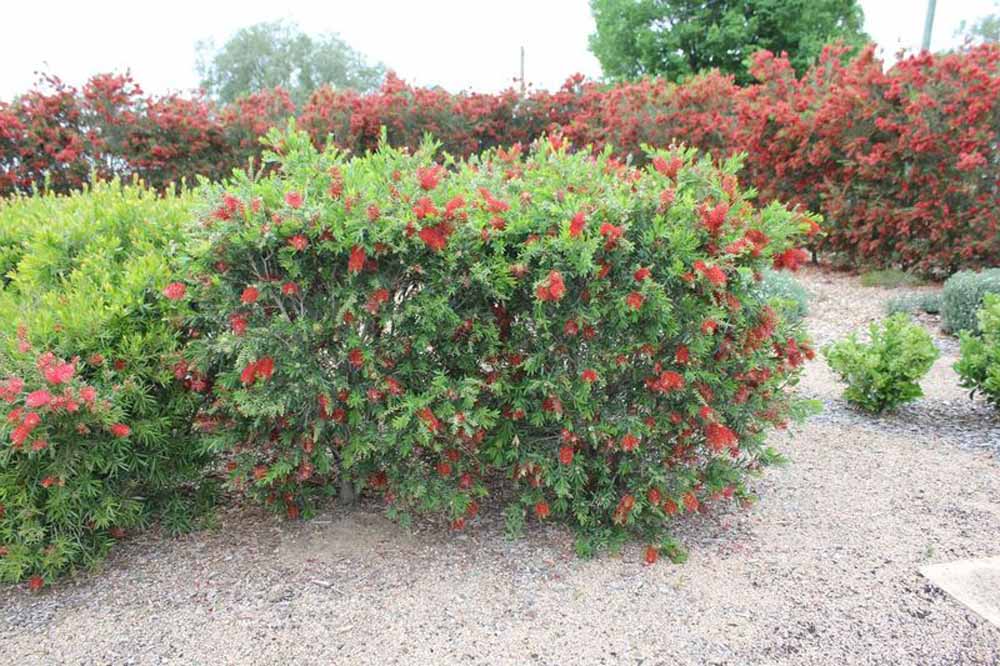
Slim™Callistemon viminalis ‘CV01’ PBR
Slim™ Callistemon is a unique bottlebrush cultivar with a narrow growth habit, perfect for tight planting areas and fencelines. It produces a large number of flower buds in the spring that open to the classic bottlebrush flowers throughout spring, summer, and again in autumn. It has been tested down to -6 degrees Celsius, showing no leaf burn, which is excellent for a Callistemon. This variety is tolerant of flooding and drought, as well as being tolerant of phytopthora and myrtle rust.
Size:
- Height: 3 metres
- Width: 1.3 metres
Preferences:
- Position: Full sun to part shade
- Soil Type: Suits most soil types. Tolerates drought and frost.
Care:
- Water as required for 8-13 weeks until established.
- Plant in a well-mulched garden, with chunky mulch recommended.
- Use slow-release fertiliser in spring if necessary.
- Prune 1-3 times a year after flowering to maintain shape, depending on the desired form. More frequent pruning results in a tidier hedge or shape.
Climate (Where it works):
- Queensland (QLD)
- New South Wales (NSW)
- Australian Capital Territory (ACT)
- Victoria (VIC)
- Tasmania (TAS)
- South Australia (SA)
- Western Australia (WA)
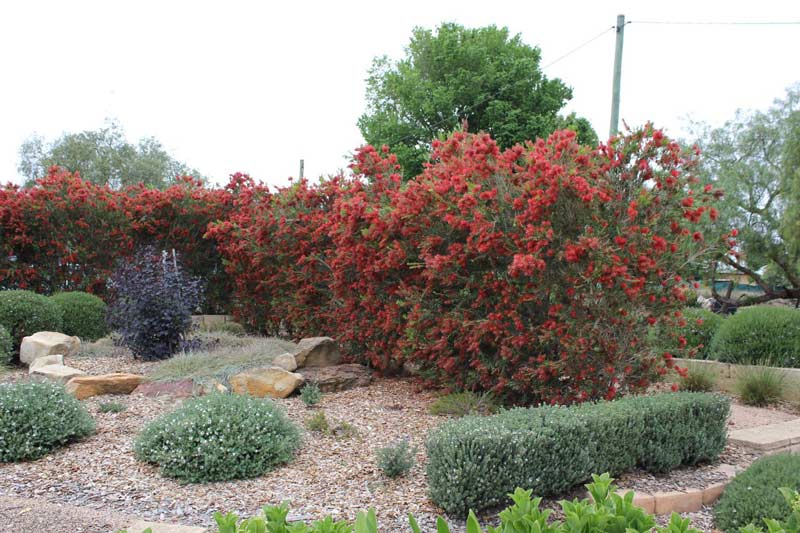
Coastal Pink™ Correa alba ‘COR10’ PBR
Coastal Pink™ Correa is a new pink-flowered form of the popular coastal Correa alba. It has a strong growth habit and is ideal for use as a medium shrub or hedge. This cultivar is particularly suitable for coastal landscapes, attracting birds and serving well as a landscape filler between trees, or mass planted as a medium-sized shrub on slopes.
Size:
- Height: 2 metres
- Width: 2 metres (can be kept smaller with pruning)
Preferences:
- Position: Thrives in full sun to light shade.
- Soil Type: Prefers reasonably drained soil but is adaptable to most soil types.
Care:
- Water as required for 8-13 weeks until established.
- Plant in a well-mulched garden (chunky mulch recommended).
- Low water requirements once established.
- Prune once per year to maintain a semi-compact habit or twice per year for a tidy appearance.
- Fertilise with slow-release native fertiliser.
Climate (Where it works):
- Victoria (VIC)
- Australian Capital Territory (ACT)
- South Australia (SA)
- Western Australia (WA)
- Tasmania (TAS)
- Southern New South Wales (NSW), including Sydney (in good draining soils)

Grey Box™ Westringia fruticosa ‘WES04’ PBR
Grey Box™ Westringia has a compact form and striking grey foliage, complemented by white flowers that bloom from September to May. It’s an excellent drought-and-flood-tolerant alternative to the English Box and can be used as a hedge or left unpruned in its natural ball shape.
Size:
- Height: 30 – 45 cm unpruned; 30 cm pruned
- Width: 30 – 45 cm unpruned; 30 cm pruned
Preferences:
- Position: Thrives in full sun to light shade.
- Soil Type: Suitable for most soil types and tolerates frost and drought conditions.
Care:
- Water as required for 8-13 weeks until established.
- Plant in a well-mulched garden with chunky mulch recommended.
- Use slow-release fertiliser in spring if necessary.
- The plant can be left unpruned in its natural shape or pruned 1-3 times a year after flowering depending on the desired shape.
Climate (Where it works):
- Queensland (QLD)
- New South Wales (NSW)
- Australian Capital Territory (ACT)
- Victoria (VIC)
- Tasmania (TAS)
- South Australia (SA)
- Western Australia (WA)
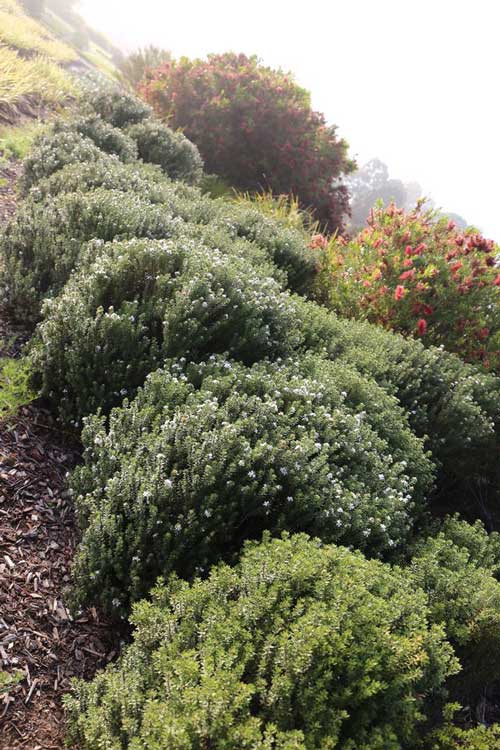
Naringa™ Westringia hybrid ‘WES01’ PBR
Naringa™ Westringia could be the best hedging Westringia for medium to tall hedges, featuring a tidy form and masses of mauve flowers in spring and periodically throughout the year. It requires pruning about half as much as other Westringias, and in some settings, it may not need pruning at all.
Size:
- Pruned: 1 metre high x 60 cm wide
- Unpruned: 2.2 metres high x 1.5 metres wide
Preferences:
- Position: Full sun to part shade
- Soil Type: Suited to sandy to well-drained clay soils; avoid wet feet and depressed planting areas
Care:
- Water as required for 8-13 weeks until established.
- Plant in a well-mulched garden with chunky mulch recommended.
- Apply slow-release fertiliser in spring if necessary.
- Can be left unpruned in its tidy natural form or pruned 1-3 times a year after flowering for a neater hedge or shape.
Climate (Where it works):
- New South Wales (NSW)
- Australian Capital Territory (ACT)
- Victoria (VIC)
- Tasmania (TAS)
- South Australia (SA)
- Western Australia (WA)
- South East Queensland (QLD) (not suited to Northern QLD)
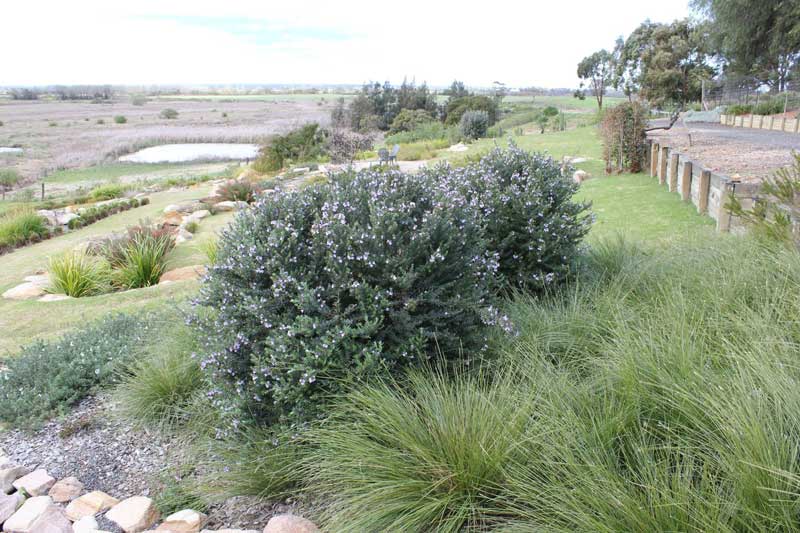
Conclusion
South-facing slopes can be challenging growing environments, particularly when the gradient is steep. Installing mulch for gradual slopes or ground-covering plants for steeper slopes can help control erosion and improve soil quality beneath those plants.
Selecting full-sun-to-part-sun-loving plants, and drought-tolerant plants is crucial for higher parts of a slope, while plants tolerant of periodic wet feet are best for the lower sections if water tends to accumulate there.

